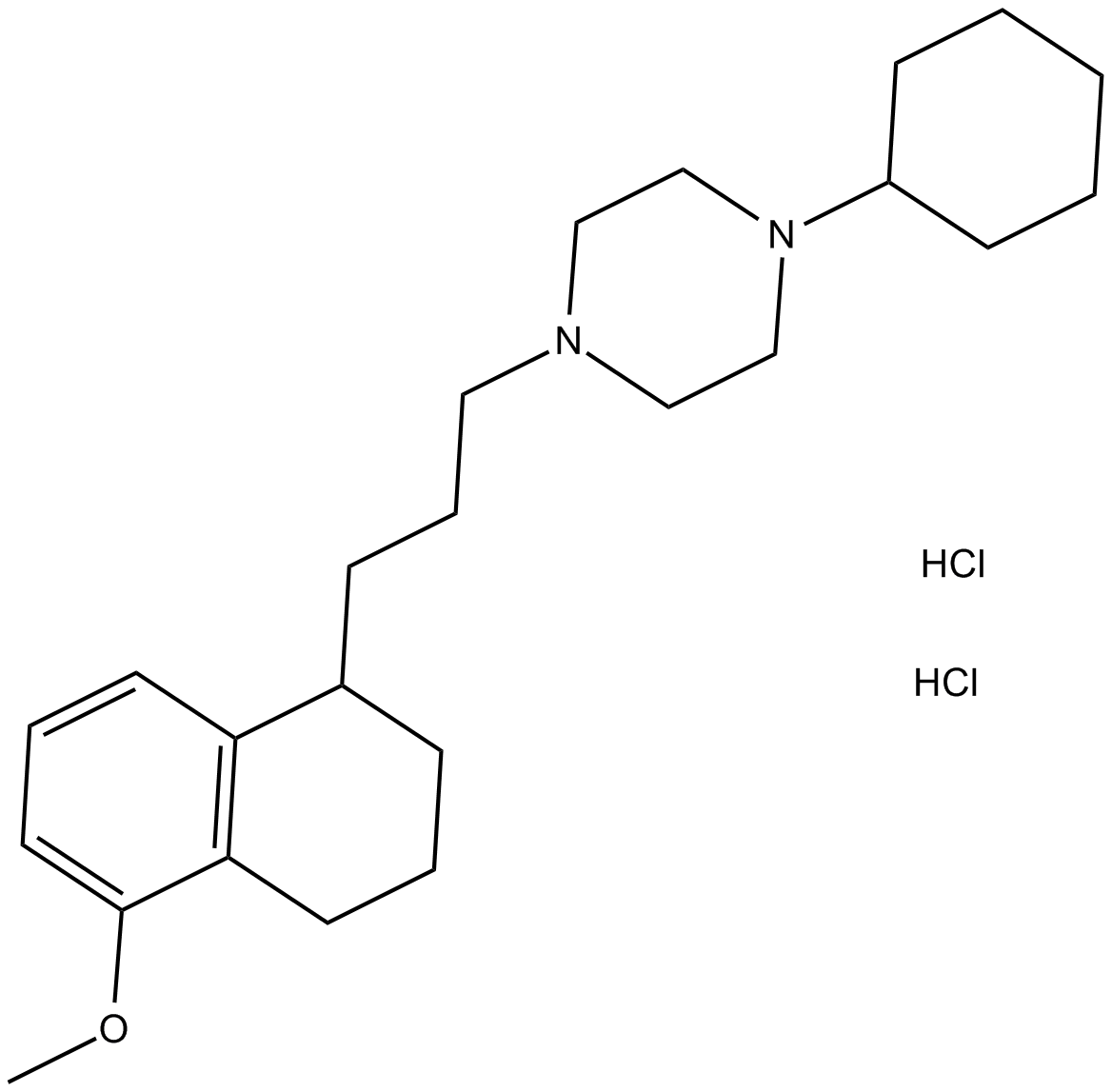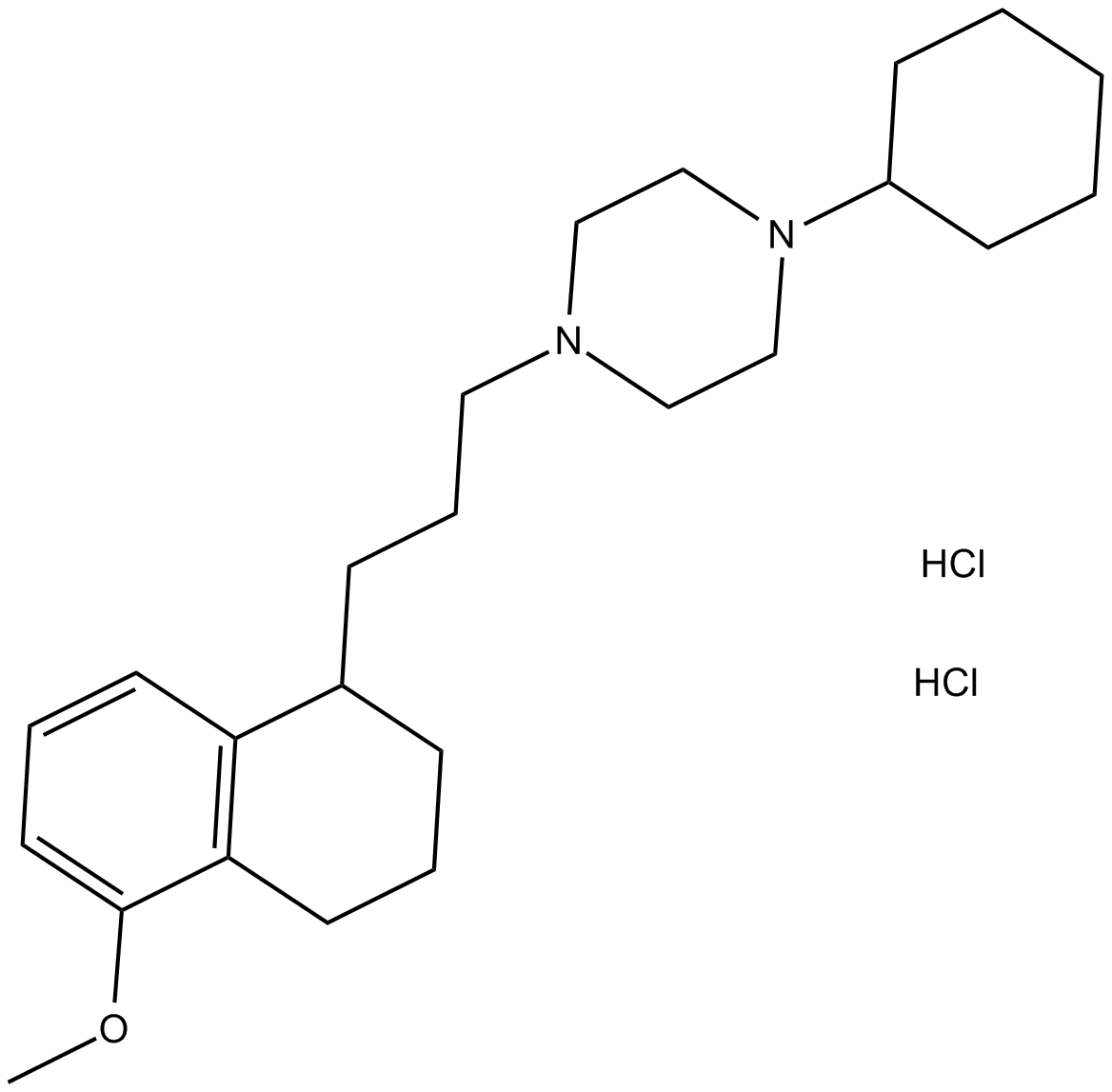PB 28 dihydrochloride
PB 28 dihydrochloride, a cyclohexylpiperazine derivative, is sigma (σ) receptor ligand, acting as a σ2 receptor agonist with a Ki value of 0.68 nM, as well as a σ1 receptor antagonist with a Ki of 0.38 nM. The σ receptor, composed of σ1 and σ2 subtypes, is present with high density in central nervous system and peripheral organs, and overexpressed in many tumor cell lines. Selective σ2 receptor agonists have been proposed as anticancer drugs, while selective σ1 receptor ligands have been proposed to develop new classes of central nervous system agents for neuroprotection, anxiety, depression, psychosis, as well as learning and memory improvement.
References:
1. Berardi F, Abate C, Ferorelli S, et al. Exploring the importance of piperazine N-atoms for sigma(2) receptor affinity and activity in a series of analogs of 1-cyclohexyl-4-[3-(5-methoxy-1,2,3,4-tetrahydronaphthalen-1-yl)propyl]piperazine (PB28). Journal of Medicinal Chemistry, 2009, 52(23): 7817-7828.
2. Azzariti A, Colabufo NA, Berardi F, et al. Cyclohexylpiperazine derivative PB28, a sigma2 agonist and sigma1 antagonist receptor, inhibits cell growth, modulates P-glycoprotein, and synergizes with anthracyclines in breast cancer. Molecular Cancer Therapeutics, 2006, 5(7): 1807-1816.
3. Pati ML, Hornick JR, Niso M, et al. Sigma-2 receptor agonist derivatives of 1-Cyclohexyl-4-[3-(5-methoxy-1,2,3,4-tetrahydronaphthalen-1-yl)propyl]piperazine (PB28) induce cell death via mitochondrial superoxide production and caspase activation in pancreatic cancer. BMC Cancer, 2017, 17(1): 51.
| Physical Appearance | White solid |
| Storage | Store at 4°C |
| M.Wt | 443.5 |
| Cas No. | 172907-03-8 |
| Formula | C24H38N2O·2HCl |
| Solubility | <8.87mg/ml in H2O |
| Chemical Name | 1-cyclohexyl-4-(3-(5-methoxy-1,2,3,4-tetrahydronaphthalen-1-yl)propyl)piperazine dihydrochloride |
| SDF | Download SDF |
| Canonical SMILES | COc1c(CCCC2CCCN(CC3)CCN3C3CCCCC3)c2ccc1.Cl.Cl |
| Shipping Condition | Small Molecules with Blue Ice, Modified Nucleotides with Dry Ice. |
| General tips | We do not recommend long-term storage for the solution, please use it up soon. |
| Cell experiment:[2] | |
|
Cell lines |
Human breast cancer cell lines, MCF7 and MCF7 ADR (resistant to Adriamycin or doxorubicin) |
|
Reaction Conditions |
25 and 15 nM PB 28 dihydrochloride for 2 d incubation |
|
Applications |
PB 28 dihydrochloride inhibited growth of MCF-7 and multidrug-resistant MCF7 ADR cells, with IC50 values being 25 and 15 nM, respectively. PB 28 dihydrochloride also decreased basal P-glycoprotein levels in the same cells. |
| Animal experiment:[3] | |
|
Animal models |
C57BL/6 mice bearing Panc02 tumors |
|
Dosage form |
10.7 mg/mL Once daily by intraperitoneal injection for 2 weeks |
|
Applications |
PB 28 dihydrochloride treatment inhibited tumor growth in Panc02 tumor burden mice. Even though treatment was discontinued (on day 15), PB 28 dihydrochloride also conferred a survival advantage for mice in this experiment. |
|
Note |
The technical data provided above is for reference only. |
|
References: 1. Berardi F, Abate C, Ferorelli S, et al. Exploring the importance of piperazine N-atoms for sigma(2) receptor affinity and activity in a series of analogs of 1-cyclohexyl-4-[3-(5-methoxy-1,2,3,4-tetrahydronaphthalen-1-yl)propyl]piperazine (PB28). Journal of Medicinal Chemistry, 2009, 52(23): 7817-7828. 2. Azzariti A, Colabufo NA, Berardi F, et al. Cyclohexylpiperazine derivative PB28, a sigma2 agonist and sigma1 antagonist receptor, inhibits cell growth, modulates P-glycoprotein, and synergizes with anthracyclines in breast cancer. Molecular Cancer Therapeutics, 2006, 5(7): 1807-1816. 3. Pati ML, Hornick JR, Niso M, et al. Sigma-2 receptor agonist derivatives of 1-Cyclohexyl-4-[3-(5-methoxy-1,2,3,4-tetrahydronaphthalen-1-yl)propyl]piperazine (PB28) induce cell death via mitochondrial superoxide production and caspase activation in pancreatic cancer. BMC Cancer, 2017, 17(1): 51. |
|
Quality Control & MSDS
- View current batch:
-
Purity = 98.00%
- COA (Certificate Of Analysis)
- MSDS (Material Safety Data Sheet)
Chemical structure









